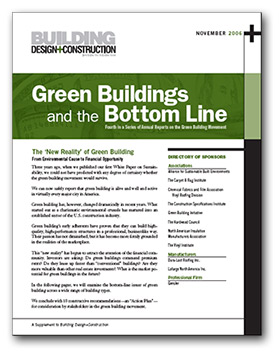Green Buildings and the Bottom Line
 Green building has changed dramatically in recent years. What started out as a charismatic environmental crusade has matured into an established sector of the U.S. construction industry. Green building’s early adherents have proven that they can build high-quality, high-performance structures in a professional, businesslike way. Their passion has not diminished, but it has become more firmly grounded in the realities of the marketplace. The green building movement is alive and well in North America, as pioneering developers and architects have proven that sustainable buildings are financially sound and even potentially lucrative, concludes a recent review of the sector.
Green building has changed dramatically in recent years. What started out as a charismatic environmental crusade has matured into an established sector of the U.S. construction industry. Green building’s early adherents have proven that they can build high-quality, high-performance structures in a professional, businesslike way. Their passion has not diminished, but it has become more firmly grounded in the realities of the marketplace. The green building movement is alive and well in North America, as pioneering developers and architects have proven that sustainable buildings are financially sound and even potentially lucrative, concludes a recent review of the sector.
A recent edition of Building Design and Construction (BD+C) contains an examination of progress in green building in the United States, and details the financial implications of sustainable building in a comprehensive report, Green Buildings and the Bottom Line.
The report shows that green building has matured from its early days as an environmental ‘crusade’ into a well established construction sector with a strong business backing. The shift from an environmentally principled approach to a view of green building as a lucrative financial opportunity is the focus of the paper.
As recently as three to four years ago, the feasibility of the U.S. Green Building Council’s Leadership in Energy and Environmental Design (LEED) standard was in doubt, with fearful predictions it could add as much as 20% to the cost of construction. Today, LEED is an established, respected development tool in Canada and the United States, with LEED-trained architects and designers now very much in demand.
The predictions of high costs did not come true. A number of studies have confirmed that the premium is actually quite low, and that this investment can be paid back in a few short years through lower energy costs and other savings.
In late 2003, The Massachusetts Technology Collaborative, a state agency which promotes renewable energy and innovation, published one such study by Greg Kats which surveyed 33 LEED buildings across the U.S. The findings showed an average premium of just 1.84%, from a low of 0.66% for LEED Certified buildings to a high of 6.5% for LEED Platinum.
Another industry study concluded that “many projects achieve sustainable design within their initial budget, or with very small supplemental funding.”
As well, says the BD+C report, “experienced builders using integrated design and off-the-shelf solutions - such as low-e glazing, “cool” or vegetated roofs, energy-conserving lighting, dual-flush toilets, low-demand landscaping, and grey water irrigation - could readily bring in even the most sophisticated projects at a cost owners and developers could be happy with.”
As a result, blue-chip companies such as Bank of America, Ford Motor Company, General Motors, Honda, Starbucks, Swiss Re, Toyota, and Whole Foods, have chosen to build to green standards with major new projects.
With the business case becoming clearer, developers, property investors, building owners, real estate investment trusts, and pension funds are also turning their investment eyes towards sustainable building projects.
The report examines bottom-line issues of green building across a wide range of building types and sectors – industrial, commercial, educational, health-related and residential. It concludes with 10 constructive recommendations—an “Action Plan”—for consideration by stakeholders in the green building movement.
This “new reality” has begun to attract the attention of the financial community. Investors are asking: Do green buildings command premium rents? Do they lease up faster than “conventional” buildings? Are they more valuable than other real estate investments? What is the market potential for green buildings in the future?
This report, examines the bottom-line issues of green building across a wide range of building types. It concludes with 10 constructive recommendations—an “Action Plan”—for consideration by stakeholders in the green building movement.
You can return to the main Market News page, or press the Back button on your browser.

